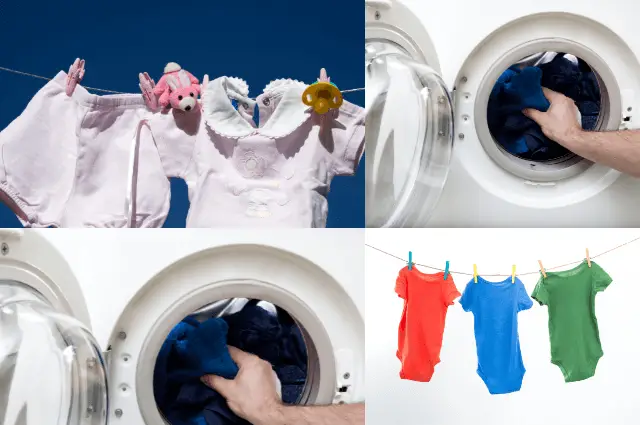Handling of babies’ clothing items is an important topic that is often discussed among mothers. Unlike adults who can wash and dry clothes anyhow they wish, baby clothes require that they be handled delicately to avoid rashes on the baby’s skin, shrinkage, and fading.
Hey! By the way… any links on this page that lead to products on Amazon are affiliate links and I earn a commission if you make a purchase. Thanks in advance – I really appreciate it! .
Baby clothes are made with different fabrics, which makes them react in different ways when dried, and that’s why most manufacturers attach guidelines on how to wash and dry them.
Should I Air Dry or Tumble Dry my Baby’s Clothes After Washing?
Drying sometimes seems essential, especially when there is a lack of space. However, mothers must ensure that clothes are adequately dried before storing them to avoid causing redness on delicate skin. While some mothers believe that baby clothes should be air-dried, some still prefer tumble drying.
This article will critically examine the pros and cons of each method
Air Drying Baby Clothes
Sun and a little wind seem to be the perfect weather for drying clothes outside while saving electricity. Air drying is a technique that allows you to air the baby’s clothes on a line for it to dry. This method is just so easy as it allows the clothes receive a touch of freshness.
Can One Dry Baby Clothes Outside?
Most often, mothers who would want to air dry are confused with questions like this. Drying your baby’s clothes outside is a great idea, even when it’s cold. Studies have shown that the ozone in the air is a natural disinfectant, however, its concentration is too low to kill viruses, but it still has little effect on bacteria and helps drive away bad smells.
Benefits and Disadvantages of Air-Drying Baby Clothes
Benefits:
- Asides from the effect ozone have on the fabric, the natural smell it leaves on the cloth is calm and soothing.
- Air drying protects the baby’s clothes from shrinkage. It ensures clothes are left undeformed.
- Cases of wear and tear are so minute when it comes to air drying
- With air-drying, you save at least 10% of electricity compared to tumble drying
Disadvantages of Air-Drying Baby Clothes:
1. Most times, air drying tends to make the clothes a bit rough, making them difficult to iron.
However, to avoid issues like this, it is advised white vinegar is used during the rinsing of the clothes. This will help to soften the clothes.
2. Another problem mothers often encounter with air drying is the discoloration of clothes.
To avoid encountering such, colorful and black clothes should be spread under shades.
3. Another disadvantage of spreading baby clothes outside is that you could bring them in with tiny insects on them.
These insects tend to discomfort your baby. However, it is always advised to iron your baby’s clothes before putting them on for them.
4. The issue of running out to bring in clothes while it is raining could deter mothers from air drying
Tumble Drying
We often come across the term “tumble dry” on cloth labels and can’t help but wonder what that means. Tumble drying is a technique that involves the use of a dryer instead of air drying.
Most mothers are conversant with spreading their baby’s clothes outside, but that doesn’t dispute that tumble drying is convenient and speedy.
Can One Tumble Dry Baby Clothes?
Tumble drying is for everyone, and babies’ clothes are not left out. Most baby wears come with instructions on how to handle them. It is vital to adhere to such instructions.
What Setting Can One Tumble Dry?
Many mothers face drying problems in scenarios like the absence of a balcony in the apartment and bad weather. These scenarios can make drying difficult, and in such cases, one can prefer to tumble dry. Tumble dry can be done when the cloth manufacturer is instructing it.
The instruction is often “tumble dry low,” which means low heat should be used for drying. It has been proved that low heat is the safest method of drying when you are trying to avoid shrinkage.
Benefits and Disadvantages of Tumble Dry
Benefits:
- Tumble dryers do not use up much space as compared to using clotheslines. This particular benefit makes it ideal for mothers in an apartment without a balcony or little space.
- Tumble drying saves time and the energy of spreading clothes on a line, bringing in and stretching wrinkled clothes.
- The dryer emanates heat that is capable of destroying all traces of viruses and bacteria.
Disadvantages:
Shrinkage:
Experiments I carried out have shown that the heat emanating from the dryer tends to contract fibers. This contraction leads to shrinkage, and this is why most times, after using a dryer, you discover that your baby’s sock may no longer fit in.
Dryer indeed saves time, but you might have to spend money getting extra socks. Would you instead save time or money? It’s left for you to decide.
Cloth damage:
Have you tried cleaning out the lint tray of your dryer?
During such cleaning, You may discover that the tray is full of fluff. Fluff are collections of tiny fibers from your cloth. So, imagine that every time you dry a cloth, tiny fluff is collected. Continuous collection of fiber weakens the cloth resulting in wear and tear.
Another disadvantage of using a dryer is that it consumes so much electricity and not all clothes can be tumble dried.
Conclusion
In argument of which method is the best, I would say the best is ultimately the one that suits you. In deciding a method that suits you, a lot of factors are put into consideration. Some of these factors are:
Instructions on the cloth label: always take note of that
Climate region and space: if for instance, you live in a warm region and have a garden, you know which method suits
If, on the contrary, you live in a small apartment in a cold region like Alaska, nobody will blame you for tumble drying.
Hence, I would advise you to choose a method that suits you and make sure you are doing it right to avoid damaging your baby’s clothes.

